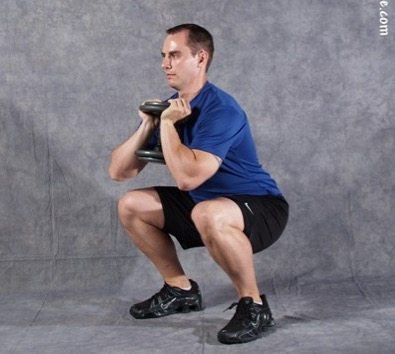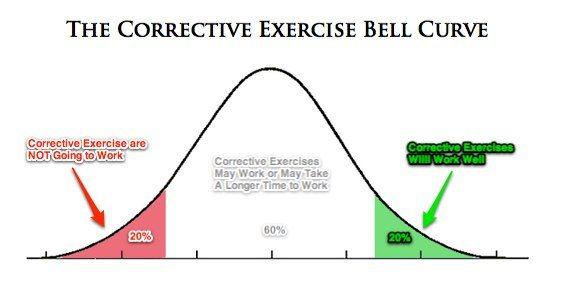Today’s article is an AMAZING guest post from my friend Dean Somerset. I’ve been talking a lot lately about how hip anatomy should change your mechanics and why exercises like squats should be individualized based on each person, but Dean blows this topic out of the water with this article. If you love this stuff as much as I, check out the link at the bottom for Dean and Tony Gentilcore’s new program, The Complete Shoulder & Hip Blueprint. This is just the tip of the iceberg of what is covered in the program.
Hip Variations and Why My Squat Isn’t Your Squat
In a recent workshop, I had a group of 50 fit and active fitness professionals and asked them all to do their best bodyweight squat with a position that felt good, didn’t produce pain, and was as deep as they could manage. As you can imagine, looking around the room produced 50 different squats. Some were wide, narrow, deep, high, turned out feet or some variation all of the above.
Did these differences mean there was a standard everyone should aim for, and those who weren’t there had to try to improve their mobility or strength or balance in that position? Maybe, but there’s probably a bunch of other reasons as to why 50 people have 50 different squats.
A standard requirement for powerlifting is to squat to a depth that involves having the crease of the hips below the vertical position of the knee. That’s probably the only known requirement for squat depth out there. The universal recommendation of “ass to grass” depth being the best thing since sliced bread may sound nice on paper (or in Instagram videos or Youtube segments), but it might be something that’s relatively difficult for some people to achieve, and for others it could be downright impossible, regardless of how much mobility work or soft tissue attacks they go through. The benefits of a deep squat seem to only be reserved for those who have the ability to express those benefits by accessing that range of motion without some other compensatory issue.
Let’s just consider simple stuff like anthropometric differences between individuals. Someone who is taller will have a bigger range of motion to go through to hit a parallel position than someone who is shorter, and someone with longer femurs in relation to their torso length will have a harder time maintaining balance over their base of support compared to someone who has shorter femurs. A long femur could be any femur that comprises more than 26% of an individual’s’ total height. So someone who is tall and long femured will have trouble getting down to or below parallel due to simply having the limb lengths to allow the bar to stay over the base of support during the squat motion without losing balance one way or the other.
Not as commonly known is the degree of retroversion or anteversion the femoral necks can make. The shaft of the femur doesn’t just always go straight up and insert into the pelvis with a solid 90 degree alignment. On occasion the neck can be angled forward (femoral head is anterior to the shaft) in a position known as anteversion, or angled backward (femoral head is posterior to the shaft) in a position known as retroversion. Zalawadia et al (2010) showed the variances in femoral neck angles could be as much as 24 degrees between samples, which can be a huge difference when it comes to the ability to move a joint through a range of motion.
The acetabulum could itself be in a position of anteversion or retroversion, and this difference itself could be more than 30 degrees. This means the same shaped acetabulum would give someone who has the most anteverted acetabulum 30 extra degrees of flexion than someone who had the most retroverted acetabulum, but would give them 30 degrees more extension than the anteverted hips.
There’s also the differences in centre-edge angles, or the angle made from the center of the femoral head through the vertical axis and the outer edge of the lateral acetabulum. Laborie et al (2012) measured this angle in 2038 19 year old Norwegians, and found that it ranged from 20.8 degrees to 45.0 degrees with a mean of 32 in males and 31 in females.
Now to throw even another monkey wrench into the problem, there’s the simple fact that your left and right hips can be at different angles from each other! Zalawadia (same guy as before) showed that the angle of anteversion or retroversion of the femur could be significantly different from left to right, sometimes more than 20 degrees worth of difference.
All of this can have a direct effect on their available range of motion. You can’t easily mobilize bone into bone and create a new range from that interaction, so if one person has hips where the bony alignment and shape doesn’t causes earlier contact in a specific direction compared to someone else who has a different shaped and aligned hip structure, it’s going to show in their overall mobility.
Elson and Aspinal (2008) showed that there can be a massive variation in both passive and active movements of the hip across age ranges and gender differences. They showed a true hip flexion range of between 80-140 degrees (mean of 25)with no lumbar rounding, a strict active straight leg raise with no lumbar rounding range of 30-90 degrees (mean of 70), and active leg raise with lumbar rounding of 50-90 degrees (mean of 86). This means someone in their sample managed to get 60 degrees more hip flexion than someone else in the sample. There was also a range of between 5-40 degrees of hip extension too, and across an age range from 19-89 years old, that’s a notable difference, especially if you work in general populations where everyone walks into the gym and over to the squat rack.
D’Lima et al (2000) found that hip flexion ROM could be as low as 75 degrees with 0 degrees of both acetabular anteversion or femoral anteversion, but as high as 155 degrees, with 30 degrees of both acetabular anteversion or femoral anteversion. An increase in femoral neck diameter of as little as 2mm was able to reduce hip flexion range by 1.5 – 8.5 degrees, depending on the direction of motion.
So essentially, your ability to achieve a specific range of motion is as much up to your unique articular geometry as it is to your strength and mobility. In many cases, it’s entirely independent of your strength and mobility, and no amount of stretching, mashing, crushing, or stripping will improve it. In many cases, trying to achieve that range of motion that’s outside of your joints ability to achieve will cause less desirable results, like bone to bone contact and irritation (potentially leading to things like femoroacetabular impingement), or compensatory movement from other joints like the SI joint or lumbar spine.
So with as much involved with the structure as I’ve presented here, and how impactful it can be to the end result of total motion of the hips during exercises, how can you determine whether it’s a limiting factor or not? If you happen to have X-ray vision you can do a good job of this, but you’d likely be charging a heck of a lot more money than you are right now for your services.
What we have available is a detailed assessment that focuses on a combination of features.
Involving a passive assessment to assume a theoretically available range of motion and shape of movement capability, an active assessment to see how they can use that range and whether there’s a difference between the two, and then determining strength or motor pattern aptitudes for the movements can be the best tools we have at our disposal, and then coaching the movement until their face sweats blood.
By using multiple approaches to assessing available and usable range of motion, you can get multiple views into a room that can paint a broader picture of what’s available. If the person has the ability to easily let their knee drop to their chest on your treatment table and squat to the floor, there’s obviously no restriction to their range of motion. If they have trouble breaking 90 degrees, even if they move wider through abduction and external rotation, their active range is limited through multiple tests, and their ability to show you a squat shows a lumbar flexion at around 90 degrees of hip flexion as well, the odds of you mobilizing that tissue to produce a significantly bigger range may be limited.
Passive Assessment of Hip Structure
Active Hip Flexion Capability Against Gravity
Active Rockback for Hip Flexion without Gravity Influence
Supported Squat Assessment
If all of these tests show a specific limitation to the range of motion consistently across all situations, it could be assumed that there would be a structural limitation versus passive insufficiency, weakness or other considerations. If active testing is limited but passive or supported assessments are fine, there could be a strength or motor pattern limitation holding the movement back.
Now sure, there’s a lot of brakes that could be restricting that range, from things like scar tissue to guarding and some soft tissue restrictions. Doing some work to help reduce that can help improve overall range of motion, but in some cases will be limited to just minimal gains. In some situations, trainers or therapists may work on improving range of motion for weeks or months and see no improvement, and in many cases the deck would be stacked against them seeing any improvement at all.
As mentioned earlier, there could also be an asymmetric structural element at play, which may necessitate an asymmetric setup for the movement where one foot is either turned out more, held slightly forward or back, or even turned into something like a one-heel elevated squat. The difference between this and a lunge is merely how far back that elevated foot is relative to the other foot, but again it’s taking advantage of potential asymmetries in structure and allowing an asymmetric set up to be more congruent with the individual.
Another way to think of it is if we have a potentially asymmetric structure yet force a symmetric set up on it, we may be creating an imbalance or compensative element in our training versus preventing it.
The Complete Hip and Shoulder Blueprint

The series is currently on a launch sale pricing, and the entire package is available for only $137 versus the regular pricing of $177. The sale is on from November 1 through 5, so act quickly to get your copy. Click below to learn more or check out the below preview video!









